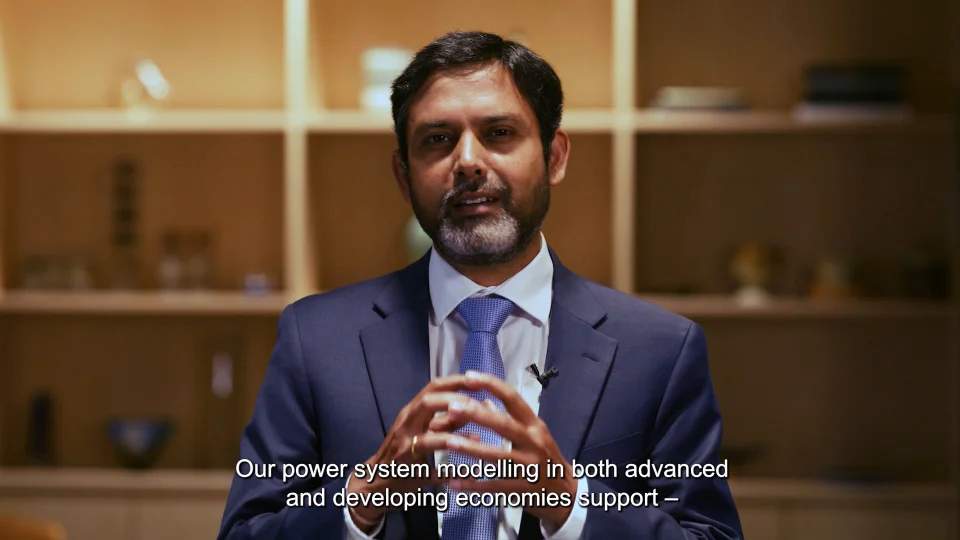
A monumental global energy transition is underway.
We see that the transition to 100% renewable energy systems is set to accelerate at an eye-popping rate. It is no longer a question of if we’ll make the journey, but when we’ll arrive at a decarbonised future.
Wärtsilä’s ‘Front-loading Net Zero’ report models cost-optimal pathways to 100% renewable power systems in different markets with vastly different socioeconomic dynamics, distinct energy systems, and challenges to overcome. In the lead up to COP26, the results show leaders how global energy systems can be transformed to avert the climate crisis and create a blueprint for every country in the world to reach net zero power before 2050, or even 2040, at the lowest cost.>
The pathways modelled show that reaching 100% renewables does not increase the cost of electricity and can in fact slash total energy costs, in comparison to today.
How can these regions reach net zero in the very near future in an economically achievable way?
A call to leaders by Sushil Purohit, President, Wärtsilä Energy and EVP, Wärtsilä.
Our analysis shows that net zero is feasible in every region as we already have all the technologies needed. The key is to front-load and start now.
What are the key steps for countries to build their paths to 100% renewable electricity systems?
See our summary for each region in the report
AGL - Australia
When planning Australia’s cost optimal system, it is crucial to remember that energy storage and thermal balancing power plants are not competing technologies, rather they are complementary solutions for improving grid reliability and resilience. AGL, for example, has since 2019 used 12 Wärtsilä dual-fuel engines, providing 211 MW of capacity, at the Barker Inlet Power Station, Torrens Island, to balance the supply of energy from renewable sources in South Australia. Recently, AGL also announced that, by 2023, a Wärtsilä 250 MW / 250 MWh battery energy storage system will reinforce the balancing capabilities of the same island power plant – forming a hybrid combination of thermal balancing power plants and battery storage.
Christian Breyer - LUT University
“This valuable report from Wärtsilä shows very clearly what can be achieved by moving away from conventional fuels towards 100% renewable energy. Reducing electricity cost and CO2 emissions in parallel generates CO2 reduction benefits. The technologies available today offer the flexibility and rapid reaction time needed to balance renewables."
Eija Rotinen - the Finnish Ambassador to Chile
"In order for the world to meet its climate goals, international collaboration is essential. Finland has worked in partnership with countries such as Chile to develop ambitious climate policies and to co-create and scale up world-class solutions. Wärtsilä is a fine example of a Finnish company developing globally significant solutions to the climate crisis and creating a vision for our 100% renewable energy future.”
SSE Lerwick - Shetland Islands, Scotland
A microcosm of the UK’s increased integration of wind power onto the power system can be seen in the Shetland Islands, where Wärtsilä will this year complete an energy storage system and an engine installation, to keep SSE’s Lerwick Power Station in balance with the local loads. The energy storage solution will support the power station’s spinning reserve functionality and is able to provide black start back-up as needed. To underpin the energy storage system, our GEMS Digital Energy Platform will integrate multiple generation sources seamlessly, to reduce costs and protect stability.

About the modelling
Wärtsilä used Plexos, a leading power market simulation software, for the power system modelling presented in the report.
The modelling defined a cost-optimal energy system structure and operation mode for a given set of constraints in
each region: power demand; available generation and storage and balancing technologies; financial and technical assumptions; and limits on installed capacity for all applied technologies.
The model is based on linear optimisation and performed on an hourly resolution for entire years. The costs of the entire system are calculated as the sum of the annualised capital expenditures including the cost of capital, operational expenditures (including ramping costs), fuel costs and the cost of GHG emissions for all available technologies.
For further details, see the report Methodology.



